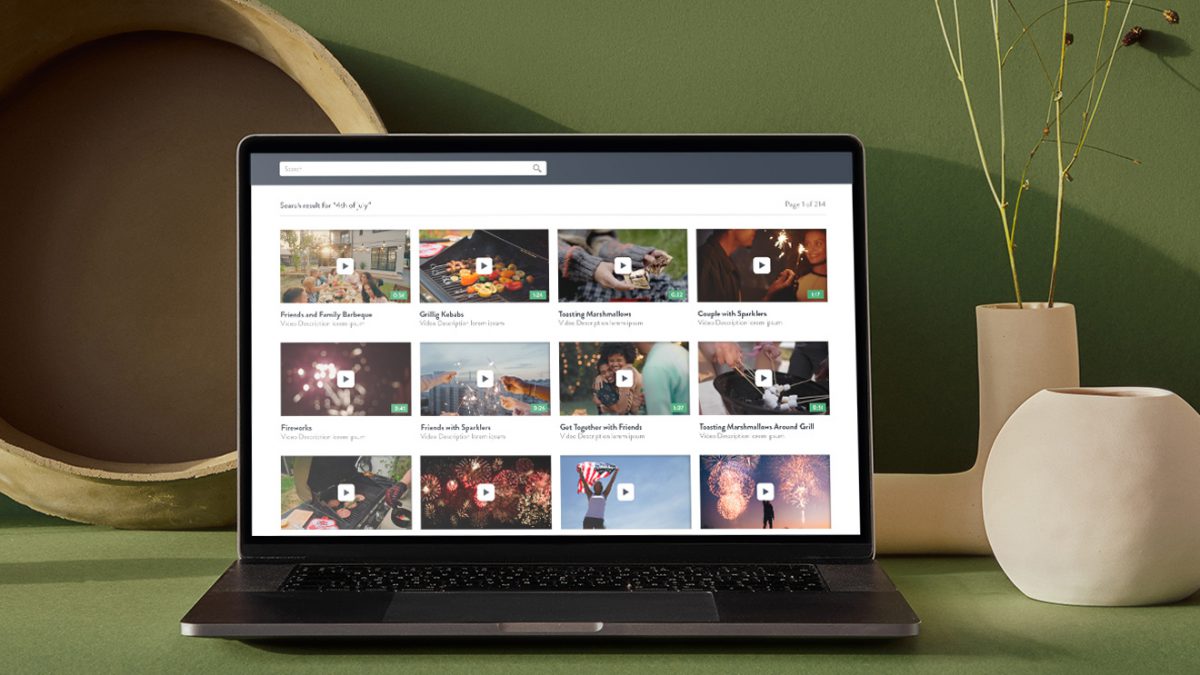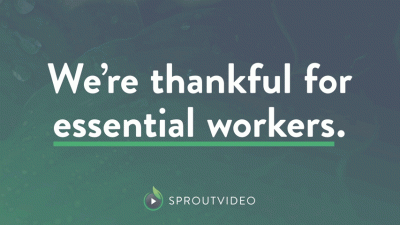What can you do when you need to produce a video, but you don’t have the time or resources to shoot original footage? Enter the wonderful world of stock video. While this is usually used to fill in the gaps of original content, you can create fully fleshed out videos in no time, with the help of some creativity and planning.
This post will walk you through the steps needed to take some stock clips you find on the internet and turn them into a marketing masterpiece.
The process we’re outlining below is the same process we used in our most recent video revolving around the 4th of July. You can watch that video below.
What is Stock Footage?
Stock footage, also referred to as stock video or B-roll, is a piece of video content that you typically use in conjunction with your main footage in larger video production. You can find these on websites for free or for sale, which we’ll cover later on.
This video content could be outtake footage, extra footage, or various other types of generic footage that creators have uploaded to various stock sites. In addition, many creators are now purposely creating generic footage to upload for the purpose of selling. Because of their nature, it becomes easier for filmmakers to find these clips and incorporate them into their projects.
Typically, you would use clips to fill in gaps when you don’t have actual footage to connect the pieces of your story. In our case, we wanted to challenge ourselves by only using stock footage for the whole piece. This is a great option for anyone who wants to create videos, but may not have the time or resources to shoot it all themselves.
Ideation of Your Video
Just like with any video, it all begins by brainstorming a concept. This is even more important when working with only stock footage since you’ll have to take into account the potential limitations of finding clips that work for the video you’re creating. For example, with our video above, we wanted to reinforce the idea of enjoying your holiday weekend — a simple concept, but one that can be accomplished quickly and will keep viewers interested.
Once you have your idea, you’ll need to flesh out some of the finer details. Will you need graphic treatments, overlays, titles, or a voiceover? Early in the creation process is the best time to sort out which elements you’ll need to make your video complete.
At this time, you may also want to outline or write out a script. Once your ideas are organized, it’ll make searching for clips that fit your narrative much easier.
Where to Find Stock Footage
When it comes to finding quality stock footage, there are two different routes you can take: paid or free. Each has its pros and cons which we’ll outline below.
Free Stock Footage
The main benefit of free stock footage is that it costs nothing. Videographers submit their work to various free stock sites as a way of getting their name out there, and you get to use their videos completely free of charge.
Years ago, much of the free stock footage libraries had few options with low quality. In more recent years, however, a lot of the footage you find may feel more natural or conceptual, giving you more unique options for your project. Of course, you’re bound to find extremely “stocky” footage no matter where you look.
Our top three free stock video sites include: Pixabay, Pexels, and Videvo.
Paid Stock Footage
Paid footage doesn’t necessarily mean the quality will be better but, in a lot of cases, it might be. You’ll most likely find more polished content and a wider variety of options than you would with free options. Plus, since the individual videographers are incentivized to upload, their libraries may be larger, giving you more options for a cohesive look when picking footage. One thing is for sure: with paid stock sites, you’re much more likely to find higher-resolution options relative to free sites.
When it comes to paying for the footage, there are typically two different avenues you can go: pay per video, or subscription-based. If you’re doing a one-off project, paying per video clip may be the way to go. Be sure to double-check the usage rights, which will vary depending on your intended use. Additionally, prices may vary depending on the video quality of the footage you’re downloading.
When it comes to subscription-based sites, you typically would pay a yearly or monthly fee that gives you access to downloading a certain amount of videos per month. This usually offers different price tiers for different video quality, but may be a good cost-effective solution for those using a lot of stock footage.
Some of our favorite paid stock sites include: Shutterstock, Storyblocks, and Dissolve.
How to Search for Stock Footage
To put it bluntly, there is a lot of bad stock footage out there. And when we say bad, we mean it’s too … stocky. The footage you want to find has to be unique enough and high quality enough that those who see your videos second guess if it’s a stock clip or not. So for that reason, searching for high-quality footage that works for your project may be a time-consuming process.
Luckily, if you already created an outline for your video, you’ll already have the specifics in mind to search in an efficient manner. Follow these tips to make this process a bit quicker.
1. Be Very Specific
If you search generic terms like “office” or “video”, you’ll get generic results. Try making your search as specific as possible. You’ll get fewer results but, ideally, they will be more in line with your vision.
2. Utilize Common Associations
While you can find a lot of different types of content on stock video sites, you’re bound to run into an idea that you can’t quite find the correct clip for. When this happens, you can pivot and search clips that represent the idea you’re trying to get across. For example, if you want a clip that represents love, you could use a clip of two people kissing. Viewers are very good at making connections through imagery.
3. Use All of the Filters
Many of the stock sites we mentioned above have filters you can implement to narrow your search. Use as many as applicable. Similar to being very specific in your search, using filters will give you fewer results, but they will be much more in line with your project outline.
4. Explore Clips from the Same Creator
Depending on your project, it may be useful to find more clips from the same creator. Typically, when someone is uploading stock footage to one of these sites, they’ll have a whole series of clips from the same shoot or scene, covering different angles, setups, or takes. If your goal is to have a cohesive video, utilizing clips from the same filmmaker will help create that illusion.
5. Try it Out
When in doubt, download the clip and try it in your edit. While some clips will give you an immediate sense that they will work in your sequence, other clips may be a bit more difficult to judge. Whether you’re searching free or paid sites, it’s easy to download and test as many clips as you need. For our video above, we downloaded over 30 clips and used the best 14.
Putting It All Together
At this point, you’ll have your idea, outline, and stock footage ready to come together into a final product. You’ll most likely need to do some trial and error to find out exactly what works best for your final edit. Additionally, you’ll absolutely need a great soundtrack to help bring your project together. For tips on finding the right song for your video, explore our post on finding music.
Creating a video with just stock footage can be a challenging task, but it certainly isn’t impossible. With proper planning and an effective search method, you’ll be able to create a cohesive story that will hopefully have your audience second-guessing who actually shot these clips. Let us know in the comments below what tips you have for finding great stock footage.








